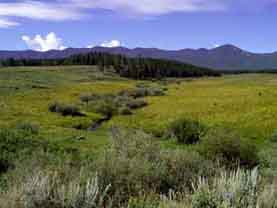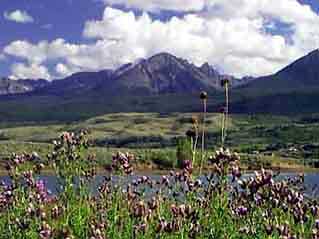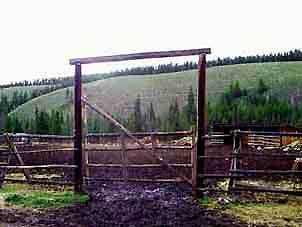A Wrangler’s Last Day
The snow on Williams Peak was fresh and seemed the antithesis of the August weather that had dried the stock ponds and wilted the flats. Now only sage could be seen where barely a month ago the Indian Paint Brush and Columbine had joined with many other native flowers and grasses in providing good grazing for the cattle. Most of the cattle had moved off the flats and were down along the Williams Fork River where the grass shared the water with many other wildlife.

The day was quite warm for Colorado high country -- too warm for the long-sleeved shirt, gloves, bandanna and cowboy hat that covered all but my face. However the power of the sun to make skin look like old saddlebags is awesome at the 8200 foot elevation of the ranch. Being outdoors from sunup to sundown six days each week made such protection essential.
There was really no good reason to be out there this day except to make one last circuit of the flats and to insure some lasting memories of treasured places. Black Jack and I had headed out to the flats by way of Lost Creek pond where several generations of beavers had built a series of dams. The beavers were not to be seen this day, but evidence of their work was abundant and greatly appreciated by a variety of animals who left many tracks among the swamp willows. Mule deer, cattle and horses were the main visitors to this pond, but coyotes, marmots, fox, bear, porcupine, weasels and blue heron had all been seen at various times.
Just below the beaver pond the trail crossed the creek, and my horse always liked to stop there and take a drink -- as we did this day. Sometimes we would leave the trail here and walk in the creek, surrounded by willows and the soothing sounds of gurgling water wending its way over rocks and logs on its journey down to the Williams Fork river and then on to the Colorado 15 miles away. On hot days my horse would splash and paw at the water to insure some of it got on her belly. In spite of her frolicking we usually managed to surprise some wild animal trying to get a drink or munch on the lush green grass along the banks. My horse also liked to grab some of the grass whenever she could get away with it. Today I let her have her way.

We passed the spot where I had found a young mule deer with a broken hind leg. She had been lying in the tall grass between some willows where she could drink water and hide from predators. The grass was still flattened. A friend and I had tried to save her, but her injury was too severe to move her and we ended up having to put her to sleep. It was the only time I have ever held a wild deer in my arms, and I was holding her when she died. I had tried to hide my tears from my cowboy friend, the head wrangler at a neighboring cattle ranch, only to find that he had a few tears of his own. We both agreed it was one of the toughest things we had ever done. My memories of that day were not happy ones, so we did not linger.
We left the serenity of Lost Creek and headed up one of the drainages toward the flats. The drainages were lined with aspen trees and provided a pleasant transition from the creek to the sage pastures above. The "flats", as we called them, were high flat areas populated by large expanses of sage brush and a few aspen groves. They dominated the Williams Fork valley and were heavily grazed by cattle in the Spring and early Summer. It was a good place to run your horse if you knew where the gopher holes were located. We did no running today because I wanted to savor each and every thing around me.
The mountain ranges on either side of the five-mile wide valley are magnificent and are permanently imbedded in my mind. The Williams Fork range, only 4 miles to the west, seemed much closer than the three hours of hard riding it took to reach its top. It was now rimmed with new snow from the night before, so there could be no more visits there until next July when the snow once again departs for its brief Summer hiatus. It seemed like yesterday that I had first marveled at those snow capped peaks, but it had been three and a half months.
We rode along the rim of the flats for about a mile, looking down into the Williams Fork river 200 feet below. My horse has no apparent fear of heights and always seemed willing to walk closer to the edge than I would allow. Across this stretch of the river the east bank is almost a sheer rise of 500 feet, after which it continues gently upward for several miles into the Arapaho National Forest. It is heavily populated with pines and aspens and sectioned off by a number of larger drainages with intriguing names such as Morgan’s Gulch, Brinker Gulch, and Outhouse Gulch. If you follow any of these gulches far enough east from the river, which we had done several times, you drop down the other side of the ridge into the Muddy Creek. It requires an all-day ride with lots of trail blazing -- the kind of riding that I loved and Black Jack tolerated.
We left the vista of the Williams Fork and headed west across the flats to one of several stock ponds once fed by the now dry Cow Creek. I wanted to see the coyote who regularly visited this pond, but neither coyote nor cattle were to be found, and what little water remained was covered with thick algae making it look like old pea soup. Disappointed, we moved on to one of my favorite places -- a meadow below the flats along the Williams Fork river. It is about an hour’s ride from the ranch and a good place to stop and take a break on a hot day.
I tied my horse to a cotton wood tree along the river and sat in the grass. The cattle were grazing all around and unwilling to leave a good meal because of us. Some of the younger calves were curious and ventured over to inspect these strange creatures who had invaded their privacy, but we provided only a short diversion, and they were soon back eating grass. The gentle trickling of the river and my horse munching grass blended to provide the most soothing sounds I have ever heard. Add to this a warm sunny afternoon, a good shade tree, and nice soft grass to lie in, and there is no man-made experience that can approach its ability to make you content and glad to be alive.

Good things always seem to end too soon, and the best things seem to end the quickest. It was time to head back to the ranch. I wanted to believe that my horse was as reluctant as I was to end a perfect day, and a perfect summer, but I would have been kidding myself. To her, going back to the corral meant getting me off her back and getting some grain and hay to eat. We had lingered by the river too long, so we ran part of the way back, which she was more than willing to do. We returned by way of Lost Creek, and my chaps absorbed more than their usual share of scratches as we loped along the winding trail through the willows and past the beaver pond.
After unsaddling her I wanted to give her one last grooming as a final good-by -- but realized that it was for my benefit and not what she wanted, so I gave her some grain and put her in the corral. I didn’t see her again, as it was still dark when I left the ranch the next morning. I did call out to her as I drove by the corral, and I am sure she heard me. I am also sure that, if she could, she would have apologized for bucking me off that time the porcupine scared her, and for the time she bit me in the back while I was tightening her cinch. I know she regrets my falling off while riding her bareback, and her stomping on my foot when something spooked her. She would thank me for walking her those many miles back to the ranch when she lost a shoe, and for all the treats I gave her. And, although she probably won’t show it, I know she will be glad to see me again next year.
• • •
Postscript: I wrote this in 1992 after my first full summer working as a wrangler. I had not yet purchased BJ. I came back the next summer and bought her.